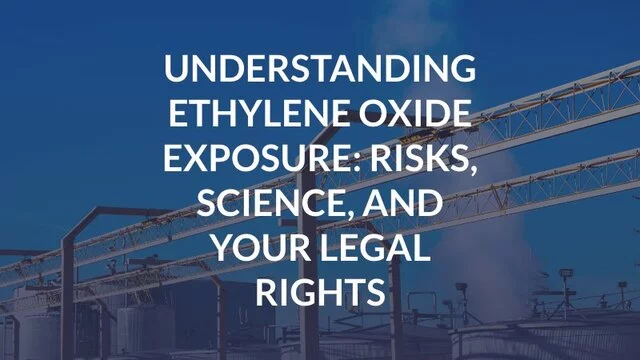
What is EtO or Ethylene Oxide?
Ethylene Oxide, or EtO, is a dangerous, toxic, man-made gas and a known carcinogen. EtO is very dangerous, even at low concentrations.
How Is It Used?
EtO is mostly used in three different ways: sterilization, fumigation, and in the production of other chemicals.
1. Sterilization
EtO is used to sterilize devices, especially those that cannot be sterilized with either steam or radiation. EtO is commonly used to sterilize equipment, including medical and dental devices, as well as certain food production equipment. According to the EPA, approximately half of all medical and dental devices are sterilized using EtO—about 20 billion devices each year.
2. Fumigation
Ethylene Oxide is used in the food industry to reduce or eliminate microbiological contamination in various products, including packaged foods, tobacco, spices, dried herbs, as well as dried vegetables.
3. Production of other chemicals
EtO is used to make other chemicals that are contained in a variety of products, including antifreeze, textiles, plastics, detergents, and adhesives.
How Might I Be Exposed?
The primary means of exposure is inhalation. According to the EPA, EtO primarily enters the environment through the air when the gas is either produced or used. Once in the air, Ethylene Oxide remains in the ambient air for at least several hours, further facilitating exposure. After it is inhaled, EtO is taken into the lungs and distributed throughout the body via the blood stream to, among other organs, the liver, kidney, testes, brain, spleen, and intestinal mucosa. There are two categories of people who are more likely to be exposed to dangerous levels of EtO:
- Workers at EtO chemical plants or employees at commercial or hospital sterilizers
- People who live near facilities that release EtO into the ambient air
It is not currently known whether the presence of EtO at hazardous waste sites poses a risk to individuals. Additionally, it is generally considered unlikely that EtO remains in or on food or water long enough to be swallowed and absorbed into the body. Although at present neither of these possible exposures is considered problematic, new evidence could alter our understanding of how EtO exposure affects individuals.
What Does the Science Say About EtO?
The dangers of Ethylene Oxide have been known for decades. The National Institute of Occupational Safety (NIOSH) recommended EtO be considered mutagenic—meaning it can cause genetic mutations—as well as possibly carcinogenic—meaning it can cause cancer—as early as 1977. At that time, NIOSH also recommended that human exposure to EtO be minimized and that alternative sterilization procedures be pursued. NIOSH confirmed the carcinogenic effect of Ethylene Oxide in 1981 based on animal studies.
In 1985 the World Health Organization confirmed that EtO is rapidly taken up in the lungs and distributed throughout the body. The EPA also classified Ethylene Oxide as a probable carcinogen and assigned it an Inhalation Unit Risk based on animal data that same year. Two years later, in 1987, California officially designated EtO as a carcinogen. And the 1990 Clean Air Act revision included EtO in a list of Hazardous Air Pollutants (HAP).
In more recent years, the EPA updated its initial classification of EtO as a “probable” carcinogen to definitively conclude that Ethylene Oxide is carcinogenic to humans. Recognizing the danger of Ethylene Oxide exposure to humans, in March 2024 the EPA issued a rule requiring commercial facilities reduce their EtO gas emissions. Despite this recent EPA ruling, there is no current scientific consensus on what constitutes dangerous threshold exposure to EtO. Thus, following this accumulation of scientific knowledge regarding the dangers of EtO, it is clear that exposure to Ethylene Oxide should be minimized to avoid risks associated with EtO exposure.
Limiting exposure can be challenging, however, given the difficulty of measuring EtO in the ambient air. According to a recent Johns Hopkins study, traditional measurement techniques are unlikely to accurately reflect EtO exposure of individuals who live near chemical plants because EtO concentrations change over time. Their study of “Cancer Alley”, an 85 mile stretch in Louisiana along the Mississippi River between New Orleans and Baton Rouge where large populations live in close contact with fossil fuel and chemical production facilities, found dramatically higher levels of EtO than the EPA had previously estimated. To accurately measure EtO emissions, the Johns Hopkins researchers created a mobile lab to directly measure Ethylene Oxide in the air, thereby significantly enhancing the technological capacity of researchers to identify EtO hot spots.

What Are the Risks of EtO Exposure?
Ethylene Oxide is known to increase the risk of multiple negative health impacts. Because Ethylene Oxide is efficiently absorbed into the bloodstream, exposure to EtO increases the risk of blood and lymphatic cancers such as multiple myelomas, lymphocytic leukemia, Hodgkin’s lymphoma, and non-Hodgkin’s lymphoma. Studies also show that EtO exposure increases the risk of breast cancer as well as cancers in connective tissues and bones. EtO exposure also increases the risk of tumors in the lungs, uterus, and brain. In addition to cancers, exposure to Ethylene Oxide has also been demonstrated to lead to increased risk of reproductive harms including increased rates of miscarriage, infertility, and developmental impairments. Risks are increased for children, as EtO can cause direct damage to DNA, thereby making early exposure more dangerous.
What Do I Do If I Think I Might Have Been Exposed?
If you suspect you’ve been exposed to Ethylene Oxide, it’s important to take immediate action. Start by identifying potential exposure sources, such as nearby industrial facilities, workplaces handling EtO, or areas with high emissions. Seek medical attention promptly to assess any health concerns and consider consulting an environmental health specialist or toxicologist for further evaluation. Document your exposure, symptoms, and any relevant circumstances to create a record.
If you’ve been exposed to Ethylene Oxide and are concerned about the potential health risks or legal implications, contact the experienced environmental litigation attorneys at Singleton Schreiber. Our team specializes in holding responsible parties accountable and can help guide you through the legal process to protect your rights.
- Counsel
Laura Singleton is a member of Singleton Schreiber’s personal injury, mass torts, and environmental litigation practices. She has a robust educational background, having earned her JD from the University of Wisconsin Law ...

